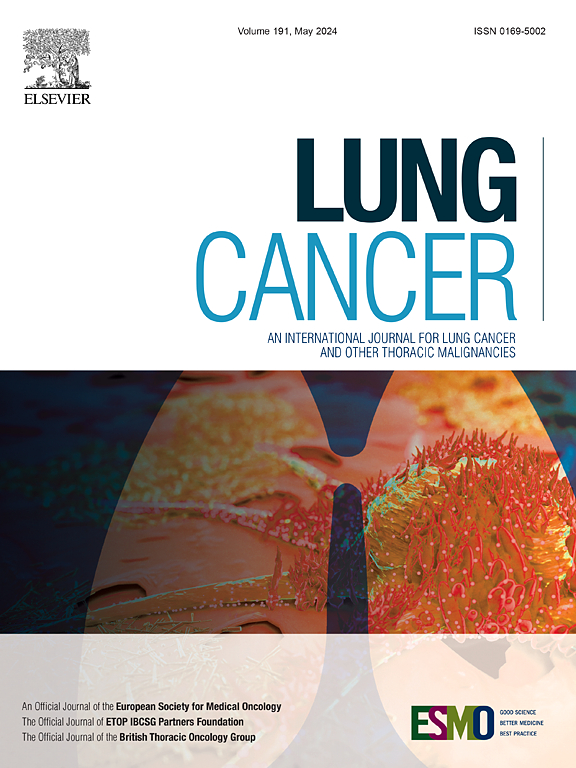肺癌放疗使用的变化——2000年至2020年挪威基于人群的研究
IF 4.4
2区 医学
Q1 ONCOLOGY
引用次数: 0
摘要
放射治疗(RT)是一种重要的癌症治疗方式。它需要大量资源,建设设施需要时间,能力规划对于向所有有需要的患者提供RT至关重要。在过去的几十年里,肺癌管理,特别是药物治疗和生存率有了相当大的进步,这可能会影响RT的需求。在这项研究中,我们调查了挪威自2000年以来肺癌RT的使用是否发生了变化。方法从挪威癌症登记处收集2000年至2020年诊断为肺癌的患者的数据,其中包含几乎完整的RT和生存数据。结果共分析55048例患者。中位年龄为71岁,44%为女性,74%为非小细胞肺癌,16%为小细胞肺癌,10%为未知组织学,46%为转移性疾病。总体而言,50%的患者接受了任何形式的放疗。接受治疗性放疗的比例增加(2000年:10%,2020年:22%),主要是由于立体定向体放疗的实施(2008年之前为1%,2020年为11%)。接受姑息性放疗的比例在前十年上升(2000年为30%,2010年为42%),到2020年下降到30%,主要原因是姑息性胸部和全脑放疗的使用减少。每年的放疗疗程数增加(从1283次增加到2328次),每名患者的疗程数在最近十年下降(从0.82次减少到0.76次)。中位总生存期显著改善(2000-2004年:6.2个月,2016-2020年:14.0个月,p < 0.001)。结论从2000年到2020年,治疗性放射治疗向治疗性放射治疗为主、缓解性放射治疗为主转变。总体而言,在此期间,放疗治疗肺癌的使用有所增加。本文章由计算机程序翻译,如有差异,请以英文原文为准。
Changes in use of radiotherapy for lung cancer – A Norwegian population-based study from 2000 until 2020
Background
Radiotherapy (RT) is an important treatment modality for cancer. It requires significant resources, building facilities takes time, and planning of the capacity is essential to offer RT to all patients in need. There have been considerable advances in lung cancer management, especially medical treatment, and survival the last decades, which might impact the need for RT. In this study, we investigated whether the RT use for lung cancer has changed in Norway since year 2000.
Methods
Data on patients diagnosed with lung cancer between 2000 and 2020 were collected from the Cancer Registry of Norway, containing nearly complete RT and survival data.
Results
55,048 patients were analyzed. Median age was 71 years, 44 % were women, 74 % had non-small-cell lung cancer, 16 % small-cell lung cancer, 10 % unknown histology, 46 % metastatic disease. Overall, 50 % received any RT. The proportion receiving curative RT increased (2000: 10 %, 2020: 22 %), mainly due to implementation of stereotactic body RT (<1% before 2008, 11 % in 2020). The proportion receiving palliative RT increased the first decade (2000: 30 %, 2010: 42 %) before decreasing to 30 % in 2020, mainly due to less use of palliative thoracic and whole-brain RT. Number of RT courses per year increased (from 1283 to 2328), courses per patient decreased the last decade (from 0.82 to 0.76). Median overall survival improved significantly (2000–2004: 6.2 months, 2016–2020: 14.0 months, p < 0.001).
Conclusion
There was a shift towards more curative and less palliative RT from 2000 until 2020. Overall, the use of RT for lung cancer increased during this period.
求助全文
通过发布文献求助,成功后即可免费获取论文全文。
去求助
来源期刊

Lung Cancer
医学-呼吸系统
CiteScore
9.40
自引率
3.80%
发文量
407
审稿时长
25 days
期刊介绍:
Lung Cancer is an international publication covering the clinical, translational and basic science of malignancies of the lung and chest region.Original research articles, early reports, review articles, editorials and correspondence covering the prevention, epidemiology and etiology, basic biology, pathology, clinical assessment, surgery, chemotherapy, radiotherapy, combined treatment modalities, other treatment modalities and outcomes of lung cancer are welcome.
 求助内容:
求助内容: 应助结果提醒方式:
应助结果提醒方式:


